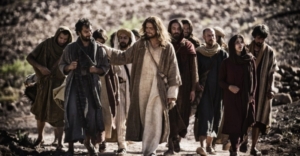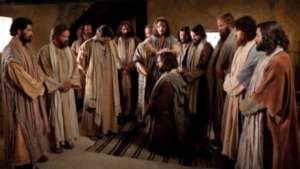Jesus and the Gentiles
 With the recent spate of racial protests in many cities, and violence in others, some might think these racial issues are fictions conjured up by politicians or the media. The reality is that in-group bias and racial prejudice are pervasive, and as old as humanity. Each culture has its nemesis. For the Armenians, it’s the Turks. For the Koreans, it’s the Japanese. For the Jews, it’s the Arabs. For the Ukrainians, it’s the Russians. Each ethnic group has a score to settle with another ethnic group.
With the recent spate of racial protests in many cities, and violence in others, some might think these racial issues are fictions conjured up by politicians or the media. The reality is that in-group bias and racial prejudice are pervasive, and as old as humanity. Each culture has its nemesis. For the Armenians, it’s the Turks. For the Koreans, it’s the Japanese. For the Jews, it’s the Arabs. For the Ukrainians, it’s the Russians. Each ethnic group has a score to settle with another ethnic group.
America is no different. The history of racial issues in America stretches back to 1619, with the introduction of slavery in this country. The Civil Rights Movement settled some issues in the 1960s, but left other issues unresolved.
Many Christians might be surprised to discover that in Jesus’ ministry 2,000 years ago, He had plenty to say about race. The racial tensions between Jew and Gentile in the ancient world was no different than our racial tensions today. Jews hated Gentiles and the feelings were mutual. In an ancient world filled with race riots, racial pogroms, and long-standing bitterness, Jesus went out of his way to minister to Gentiles.
According to Jesus’ own words, His earthly mission was aimed at a Jewish audience (Matt. 15:24). Upon commissioning His disciples, He commands them to minister to Israel exclusively: “Go nowhere among the Gentiles and enter no town of the Samaritan’s, but go rather to the lost sheep of the house of Israel.” (Matthew 10:5,6 ESV).
It made sense that Jesus focused His ministry on the Jewish people, both theologically and historically. Theologically, because of Abraham’s obedience, God had chosen the Jewish nation as His primary means of ministering to the world: “… and in your (Abraham’s) offspring shall all nations be blessed, because you obeyed my voice” (Genesis 22:18 ESV, cf. Genesis 12:3). Unfortunately, Israel performed poorly in that role: “For, as it is written, “‘The name of God is blasphemed among the Gentiles because of you’” (Romans 2:24, ESV). Because of their constant disobedience, they were living in exile in their own land under harsh Roman rule. It was in this backdrop, that Jesus came as the last in a long line of prophets, calling Israel back into its relationship with God (Matt. 12:33-41; Acts 3:22; 7:37).
Jesus’ focus on Israel also made sense historically. Their unique customs elicited strained relationships between Jews and Gentiles throughout the ancient Mediterranean world. Making matters worse, the Romans were an unwelcome occupying force in Israel. Local Roman leadership never fully grasped how much more sensitive the Jews were, to their religious scruples, than the other cultures over which Rome ruled. Aggravating the situation even more, the Roman governors sent to Palestine tended to be exceptionally inept and often greedy.
King Herod died when Jesus was a toddler. Immediately after Herod’s death, the Jews protested their harsh treatment under his rule. Their protests soon became riots. The new Roman official at the time, Sabinus, put down the rebellion and then burned down the porticos of the Temple and looted the Temple treasury. The Jewish response to Sabinus’ punitive measures was to rebel again, but this time more successfully.
They sieged Sabinus within Herod’s Palace. With the Romans under siege in Jerusalem, revolution broke out across Israel in the form of guerilla warfare. Peace was not restored until the legate, Varus, arrived as the new governor of Israel with four additional Legions under his command. He vigorously crushed the rebellion and swiftly crucified 2,000 Jewish rebels. Following the footsteps of his cruel predecessors, Varus became known for his harsh reign and high taxes. To say the least, there was bad blood between Jews and Gentiles — the Romans in particular.
So that Jesus ministered primarily to the Jews living in Galilee and Judea made perfect sense. If he had focused his ministry on Gentiles, he would have lost credibility with his Jewish audience. In this type of environment, each time Jesus crossed a racial boundary would be significant. Jesus would have taken none of these Gentile encounters lightly. In fact, each encounter would have prophetic significance: there is a lesson Jesus would be teaching His disciples, as well as us. So, with this in mind, let’s take a look at Jesus’ encounters with Gentiles.
Jesus first encounter with Gentiles is when He is visited by the wisemen when He was a toddler (Matt. 2:1 -12). It is interesting that the Gospel of Matthew, written for a Jewish audience, is the only one that includes the visit of the Magi. Presumably pagan Gentiles traveled hundreds of miles to worship the “King of the Jews.” With this visit, Matthew foreshadowed his theme of the Gentiles’ positive response to Jesus’ ministry.
Jesus’ first recorded encounter with Gentiles during his ministry was with a Roman Centurion (Matthew 8:8; Luke 7:2). A Centurion was a Roman military leader with the rank equivalent to that of a captain in the U.S. Army. Being part of the occupying Roman military force, he would have represented everything the Jews would have hated about Rome. If Jesus is looking to make a prophetic statement, meeting with a Roman Centurion was the perfect way to start.
The Centurion asked Jesus to heal his deathly ill servant. Centurions were not allowed to marry, so it is likely that this servant would have been the only “family” that he would have had. In this story, a Roman military leader asked a Jewish teacher to demonstrate an act of compassion.
How this story was told by the two different gospel writers is telling (Matt. 8:5-13; Luke 7:1-10). Writing to a Jewish audience, Matthew gave no background information about the Centurion. When Jesus arrived in Capernaum, the Centurion appeared before Jesus asking for a miracle. To see a Roman leader asking a Jew for a favor would have been shocking for Matthew’s Jewish readers.
In Matthew’s account, Jesus responded by asking “Shall I come and heal him?” (Matthew 8:7, NIV). Jesus asked the same question that Matthew’s readers would have asked. They would have said, “no.” Jews and Gentiles did not associate with each other. For a Jew to enter a Gentile home would make him ceremonially unclean. The Centurion offers a surprising response. He states that he is not worthy to have Jesus come to his house. One could imagine Matthew’s Jewish audience nodding their heads in agreement.
This is when the narrative takes a surprising turn. The Centurion then told Jesus there is no need for Him to come to his home, “only say the word, and my servant will be healed.” (Matt. 8:8). In both Matthew and Luke, Jesus said, “Truly, I tell you with no one in Israel have I found such faith’ (Matt. 8:10 ESV; cf. Luke 7:9). Jesus was saying to both his original Jewish audience and to Matthew’s Jewish readers, that this Gentile had more faith than any Jew he had ever met. Undoubtedly, that would be a difficult thing for Jews to hear.
Unique to Matthew’s account, Jesus gives some additional teaching regarding the destiny of both Jews and Gentiles. In Matthew 8:11, Jesus stated that, in heaven, many Gentiles will dine together with Abraham, Isaac, and Jacob. As mentioned earlier, Jews and Gentiles didn’t dine together, yet Jesus envisioned a day when Gentiles would dine with the Jewish Patriarchs. Jesus was saying that in the very near future the Gentiles would be included among the people of God.
The inclusion of Gentiles was an Old Testament theme that the Jews often ignored (Isaiah 2:2-5; 26:5-8; 56:3-8; 60:3-5). This statement of Gentile inclusion anticipated his disciples future Gentile mission later in the book of Matthew: “Go therefore and make disciples of all nations [the word “nations’ happens also to be the Greek word for ‘Gentile’]…” (Matt. 28:19; cf. Acts 1:8; 11:18). By the end of the book of Matthew, Jesus commissioned his disciples to minister to the Gentiles.
While his audience would still be pondering these words, Jesus would continue with some bleak news for the Jews: “… While the sons of the kingdom will be thrown into outer darkness.” Not only will the Gentiles be included into this new people of God, but the Jews would be excluded. Jewish ethnicity will not save them. They would be excluded for their lack of faith. In contrast, the Centurion serves as an exemplar of genuine humble faith. These would be piercing words for a Jesus’ audience and Matthew’s readers to hear.
Luke’s account has a much different feel. Whereas Matthew’s account becomes an open rebuke to ethnic Jews, Luke’s account focuses on the Jewish community’s goodwill towards the Centurion. In Luke, it was actually the Jewish elders who pleaded the Centurion case to Jesus, “…He is worthy to have you do this for him, for he loves our nation, and he is the one who built us our synagogue” (Luke 7:4b, 5) Reading this makes one wonder why Matthew would have withheld this vital piece of information.
Most likely, Matthew was trying to invoke the visceral antipathy that his Jewish readers naturally would have felt for the Centurion. Then he wants them to ponder over his inclusion versus their exclusion. Luke, on the other hand, was using the Centurion as a type of ideal Gentile, who loves and sacrifices for those who are racially and ethnically different from him. He freely crosses over ethnic lines. The message for Luke’s Gentile readers is that you need to love your Jewish brethren in the same way as the Centurion.
Another difference between the two accounts is that in Luke, Jesus was already en route to his home, when the Centurion’s friends intercepted him (Luke 7:6). In Luke, Jesus showed no hesitancy to cross racial lines. Jesus’ actions demonstrated that in his ministry racial barriers have been removed.
In both accounts, the audiences would have sensed the racial tension of a Jewish teacher meeting a Roman soldier, but Matthew and Luke tailored their stories to meet the needs of their specific audiences. To the Jews, the message was that Gentiles were now included among the people of God and fellowship your ethnicity does not give you a preferred status before God. The wall of Gentile exclusion has been torn down. Since God has accepted the Gentiles, you should too. The message to Luke’s audience is that we should love and help those of different races, just as the Centurion did, and we should quickly run to assist our brothers of a different race, just as Jesus did. The message, in both Matthew and Luke, is that their audiences need to embrace ethnic groups they once had scorned.
Jesus’ next encounter with a Gentile occurs in the town of Gadara, part of the Decapolis (Matt. 8:26 – 34; Luke 8:26 – 39; cf. Mark 5:1 – 20). The Decapolis was a predominantly Gentile area. Although He later commands his disciples to minister exclusively in Israel (Matt. 10:5), Jesus feels no such compunction with His ministry.
This story is included in all three synoptic gospels, with minor differences. For example, in Matthew’s Gospel, there are two demoniacs. All three Gospels, however, give the impression that Jesus’ sole purpose for traveling to this Gentile area was to heal the demoniac(s), because the moment He stepped out of the boat, he (they) appear: “And when Jesus had stepped out of the boat, immediately there met him out of the tombs a man with an unclean spirit” (Mark 5:2 ESV cf. Matt. 8:28; Luke 8:26). Jesus casts out the demons and sends them into pigs. The pigs “rushed down the steep bank into the sea and drowned in the sea” (Mark 5:13 ESV). The man was healed and, for the first time in a long time, totally sane.
The pig herdsmen told the townfolk what Jesus did. Instead of being appreciative of Jesus delivering the demoniac(s), the locals saw his actions as hurting their economy. They asked Jesus to leave.
The main point in all three Gospels is that Jesus was willing to go out of his way to the land of the despised Gentiles and show compassion by delivering a complete social outcast. Jesus not only goes out of his way, travels a land of pig farming near tombs, all of which would be unclean to Jews. Jesus does not allow typical Jewish sensibilities to keep him from helping this Gentile. He intentionally crosses well-known Jewish boundary markers to heal him.
Mark and Luke include an incipient Gentile mission. When the townspeople ask Jesus to leave, the demoniac begs Jesus to come with him. It’s understandable that the man who had just been delivered would want to remain in Jesus’ company, but the reality was that Jesus would have had problems with the Jews accepting a Gentile disciple. It is an idea way ahead of its time. Instead, Jesus commissions him as a missionary to the Decapolis: “Return to your home, and declare how much God has done for you. And he went away, proclaiming through the whole city how much Jesus had done for him” (Luke 8:39 ESV; Mark 5:20). Jesus intentionally went to a Gentile land to deliver a Gentile demoniac. Then he commissions that person to minister to other Gentiles. The Gentile mission has begun. It is interesting to note that with the book of Matthew’s focus on the Jewish mission, it omits this portion of the story.
Jesus’ last encounter with a Gentile in Matthew and Luke occurs after a theological debate with a group of Jewish religious leaders. This encounter is included in all three Synoptic Gospels. Some Scribes and Pharisees had left Jerusalem to inspect Jesus’ ministry in Galilee. They asked Jesus why his disciples were not washing their hands before they ate, violating a prominent Jewish purity ritual (Matt 15:2). Instead of responding to their question, Jesus told them that it is not what a person eats that defiles a person, but what comes out of the mouth that defiles them. This discussion about religious dietary rules is reminiscent of Peter’s vision of the sheet descending from heaven with an assortment of unclean animals on it in the book of Acts. Peter is told, “Arise Peter kill and eat.” (Acts 10:13 ESV). God tells Peter, “What God has made clean, do not call common.” (Acts 10:15 ESV).
Peter’s vision was God’s way of preparing him to minister to the (unclean) Gentiles. In both Matthew and Mark, the introduction of eating with unclean hands seems to serve a similar purpose: preparing His disciples for table fellowship with Gentiles. Jesus ended the conversation with an exclamation point. He tells the Scribes and Pharisees saying that God was preparing to uproot them from spiritual leadership and calls them “blind guides.”
It’s after this debate with Jewish religious leaders that Jesus heads deep into Gentile territory. Jesus takes his disciples to the region of Tyre and Sidon (Matthew 15:21). Tyre is about 35 miles from Galilee, while Sidon is about 50. In Jesus’ day, people would walk 8 – 12 miles per day. This would have been a three to four-day trip.
 It is here that a Syrophoenician woman begs Jesus to “Have mercy on me, oh Lord, Son of David; my daughter is severely oppressed by a demon.” (Matt. 15:22 ESV cf. Mark 7:26). She obviously knows Jesus’ reputation as a Jewish healer. Jesus ignores her pleas up until the moment His disciples demonstrate their irritation with the woman: “Send her away, for she is crying after us.” (Matt. 15:23 ESV). To the disciples, she is a Gentile nuisance that needs to go away. Jesus waits until they express their feelings before He intervenes. Instead of sending her away, Jesus engages in a conversion. Jesus plans to heal the woman, but he also wants to teach his disciples compassion.
It is here that a Syrophoenician woman begs Jesus to “Have mercy on me, oh Lord, Son of David; my daughter is severely oppressed by a demon.” (Matt. 15:22 ESV cf. Mark 7:26). She obviously knows Jesus’ reputation as a Jewish healer. Jesus ignores her pleas up until the moment His disciples demonstrate their irritation with the woman: “Send her away, for she is crying after us.” (Matt. 15:23 ESV). To the disciples, she is a Gentile nuisance that needs to go away. Jesus waits until they express their feelings before He intervenes. Instead of sending her away, Jesus engages in a conversion. Jesus plans to heal the woman, but he also wants to teach his disciples compassion.
Jesus famously answers, “I was sent only to the lost sheep of the house of Israel.” (Matt. 15:24 ESV). He has already healed several Gentiles and he made a trip into Gentile territory for the express purpose of healing a demonic. Jesus makes this ironic overstatement to a Gentile while he is at least 35 miles outside of Israel to test the woman’s faith. The irony was not lost on the woman. She knelt before Jesus and persisted: “Lord, help me.” Then Jesus calls her a dog, an animal that was unclean to the Jews: “It is not right to take the children’s food and throw it to the dogs.” (Matt. 15:26 ESV). No doubt, Jesus’ disciples thoroughly agreed with him at this point. Jesus uses the diminutive form of the word dog, with the meaning of little dog or puppy, but to the Jewish mind, the insult was firmly grasped.
For Gentiles, however, dogs were pets. A little dog would have been an adorable children’s pet. The woman takes Jesus’ phrase and turns it on its Jewish head. She sees herself, not as a dirty animal, but as a family pet that shares meals with the family: “Yes, Lord, yet even the dogs eat the crumbs that fall from their master’s table.” (Matt 15:27 ESV). Jesus’ disciples would have been blindsided: they would never have a dog at their dinner table. Jesus immediately heals her daughter, commenting on the woman’s great faith.
The Gospel of Mark includes two additional stories of Jesus interacting with Gentiles. The first of these follows immediately on the heels of our previous story of the Syrophoenician woman. According to Mark, Jesus travels from Tyre, which is 35 miles north of the Sea of Galilee and returns to the Decapolis, which is at the south end of the Sea of Galilee (Mark 7:31). This is the Gentile the same Gentile territory in which Jesus delivered the Demoniac (Mark 5:1 – 20). Apparently, the former demoniac that Jesus had commissioned to share what had happened to him did a credible job. When Jesus arrives, the people are aware that God has used Him to heal people. A crowd, presumably of Gentiles, bring a man with a speech impediment for Jesus to heal. Once again, Jesus heals the man. Mark writes this story in such a way that it gives every appearance that Jesus went significantly out of his way, headed into Gentile territory to heal this man.
Since Mark gave no indication of Jesus’ returns to Israel, the view held by most Bible scholars is that Jesus continued his ministry to the Gentiles. He attracts a crowd. After several days of being with Jesus, the crowd was hungry. According to Mark, it was here, in the Decapolis region, where Jesus fed the 4,000. In Mark, Jesus fed 5,000 Jews and later, fed 4,000 Gentiles.
Though both miracles were motivated by Jesus’ compassion, undoubtedly in this case, Jesus wished to demonstrate having compassion to Gentiles for the benefit of his disciples. One wonders when it may have dawned on His disciples that Jesus had no qualms with breaking bread with Gentiles. By Jesus’ words and deeds, he demonstrated what racial reconciliation should be like between Jews and Gentiles.
That Jesus went out of his way to travel Gentile territory twice — three times in the Gospel of Mark — each time healing Gentiles in Gentile lands, teaches us that we should be willing to leave our comfort zones and cross racial barriers to restore broken relationships.
Jesus may have focused his ministry on the Jews, but he certainly demonstrated compassion towards Gentiles, too. Jesus’ prophetic encounters with Gentiles in the Gospels, not only anticipate a future Gentile mission, but also prepared His disciples for breaking bread with the Gentiles. Jesus taught his disciples that Gentiles positive response to the Gospel meant that they were accepted by God. This would prepare them for the day when Gentiles were included into the church without converting to Judaism. With Jesus’ dialog and acts of compassion towards a hated Gentile soldier, a Gentile demoniac outcast, and Gentile woman who made herself a nuisance, healing a mute, and feeding the 4,000, Jesus models love and compassion that transcends race.
Part of his mission was that we would no longer be divided by titles or race: slave versus free; rich versus poor; Jew versus Gentile; or today, Armenian versus Turk; Ukrainian versus Russian; or Black versus White.
Jesus lived a life of racial reconciliation in a world full of racial hate. Jesus came not only to reconcile us with God, but also to reconcile us with each other: Jews and Gentiles, Armenians and Turks, and Black and White. As the Apostle Paul said, Jesus came to reconcile ALL THINGS. (Col 1:20).







